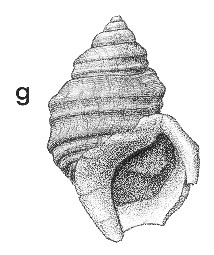
Revised descriptions of New Zealand Cenozoic Mollusca from Beu and Maxwell (1990)

 | Revised descriptions of New Zealand Cenozoic Mollusca from Beu and Maxwell (1990) | 
|
  (Pl. 29g): GS5740, S27/f8622, Hurupi Stream, Palliser Bay, southern Wairarapa, early Tongaporutuan (GNS; ex P. Wellman collection) |
Beu & Maxwell (1990): Chapter 13; p. 262; pl. 29 g.
Synonymy: Struthiolaria nana Marwick 1926c, p. 318
Classification: Struthiolariidae
Description: Small for family (28-38 mm high), moderately short and wide, with spire slightly shorter than aperture; whorls convex at first, then angled at upper third on spire; narrow, shallowly excavated sutural channel commences on second or third spire whorl and strengthens down shell, resembling that of many forms of P. vermis by last whorl. Sculpture of prominent, weakly nodulous spiral cord around shoulder angle, separated from sutural channel by wide, weakly concave sutural ramp; equally prominent, smooth spiral cord around peribasal angulation, separated from upper angle by wide, gently concave area; slightly less prominent cord in centre of mid-whorl concave area; and series of cords of decreasing prominence over base (3 and weak fourth on most specimens); whole surface crossed by many very fine, close spiral threads. Aperture large, oval; outer lip with relatively narrow varix, weakly sinuous; inner lip with usual narrow Pelicaria callus, meeting outer lip at shallow anterior notch. Protoconch broken, but apex clearly small, as in S. (Struthiolaria).
Comparison: At its two known localities, Pelicaria nana occurs with Struthiolaria praenuntia (Pl. 29i), and it closely resembles early whorls of S. praenuntia in shape, proportions, and all sculptural details, except the sutural channel that develops progressively on P. nana. Also, the basal spiral cords of P. nana are absent from S. praenuntia. It seems likely that (as suggested by Marwick 1926c, p. 318) P. nana was the earliest species of Pelicaria, and that it evolved very rapidly (at least in geological terms) from the closely similar S. praenuntia by acquiring the ability to mature at an earlier age (paedomorphosis), as shown by its acquisition of a mature outer lip (all modern Strombacea develop a thickened outer lip only when they stop growing, and reach sexual maturity). It is therefore interesting that P. nana clearly has a Pelicaria-type aperture, and yet appears to have had a conical, multispiral protoconch as in Struthiolaria. Protoconchs of fossil Pelicaria are poorly known, but one line of evidence about their nature is the rapidly speciating, multi-lineage plexus that developed in Pelicaria, presumably the genetic consequence of direct development, which is reflected in the living P. vermis (Morton 1950, p . 456) by its low, paucispiral, cap-shaped apex. It seems that this kind of multi-lineage development did not commence in Pelicaria until Waipipian time, and so it is perhaps not surprising that P. nana, the earliest species that appears to belong in Pelicaria, has a protoconch like that of the ancestral genus. The evolution of Pelicaria is apparently an example of the geologically instantaneous evolution of a genus (some workers rank it as a subgenus) by paedomorphosis, presumably as the result of a mutation in the gene(s) controlling development.
Distribution: Tongaporutuan, Tirangi Stream, North Taranaki (type), and Hurupi Stream, Palliser Bay, southern Wairarapa; very rare, in diverse, shallow-water, soft-bottom assemblages with S. praenuntia and S. callosa.
Cite this publication as: "A.G. Beu and J.I. Raine (2009). Revised
descriptions of New Zealand Cenozoic Mollusca from Beu and Maxwell (1990). GNS
Science miscellaneous series no. 27."
© GNS Science, 2009
ISBN
978-0-478-19705-1
ISSN 1177-2441
(Included with a PDF facsimile file
copy of New Zealand Geological Survey Paleontological Bulletin 58 in CD version
from: Publications Officer, GNS Science, P.O. Box 30368 Lower Hutt, New
Zealand)